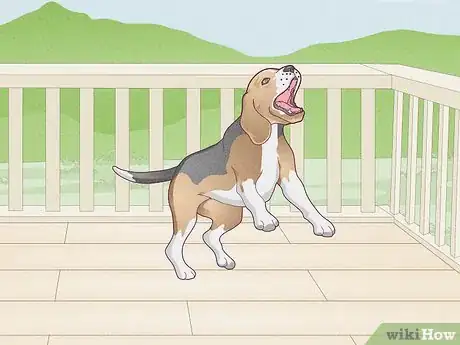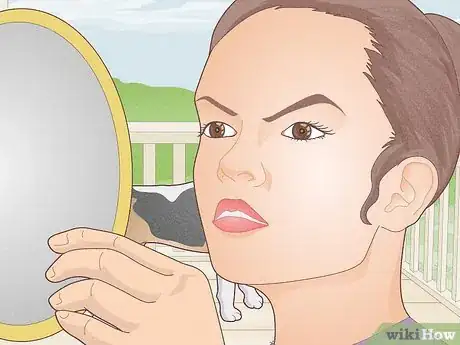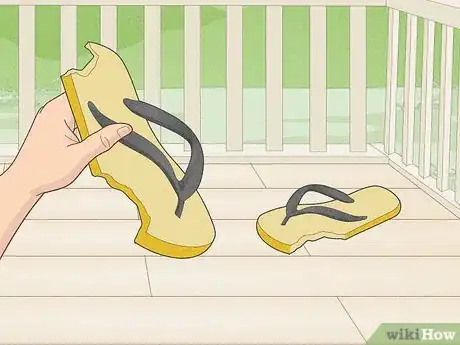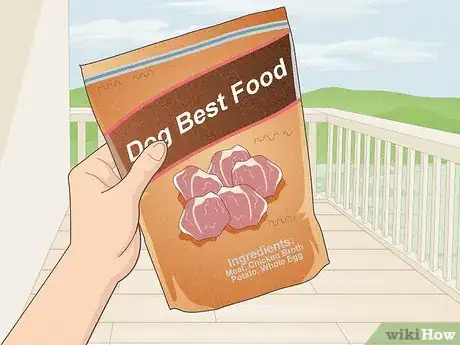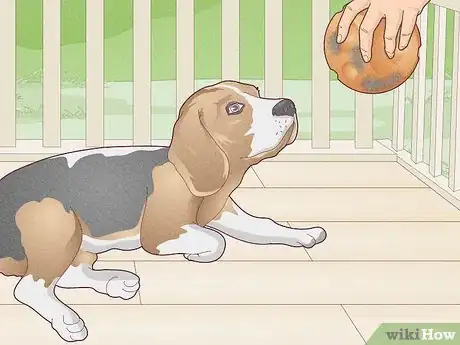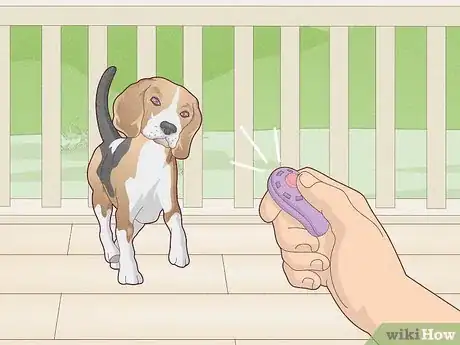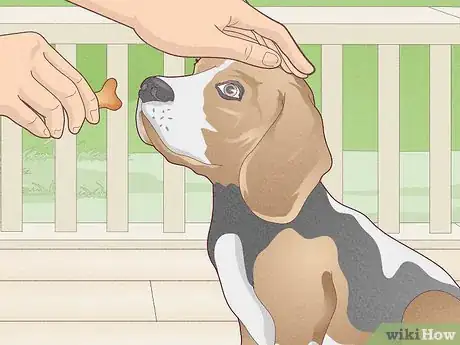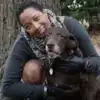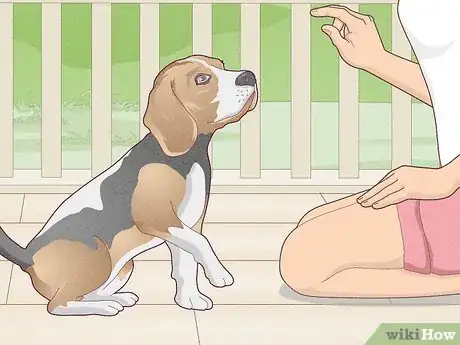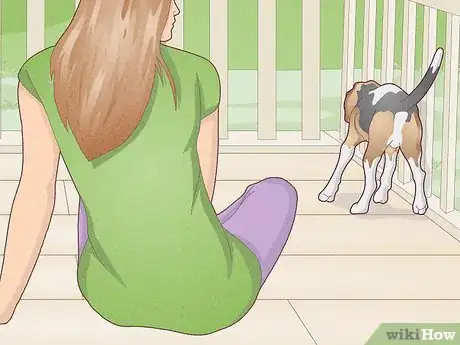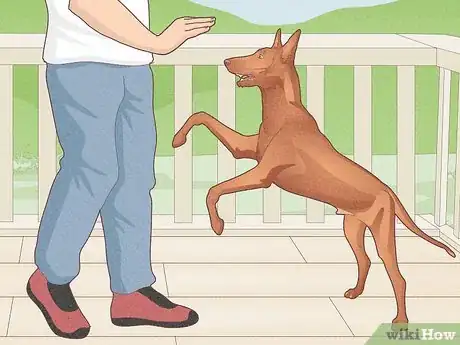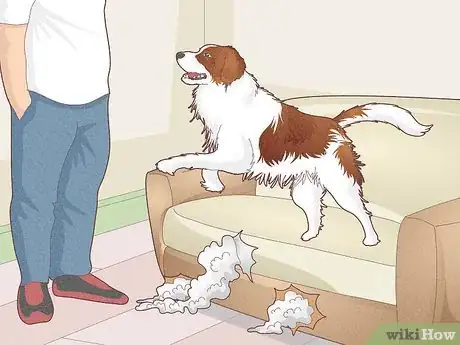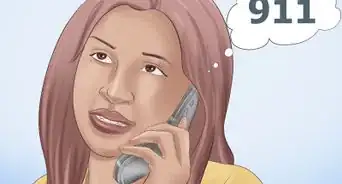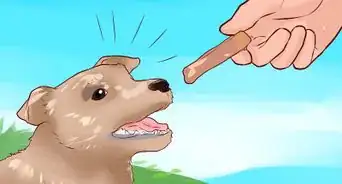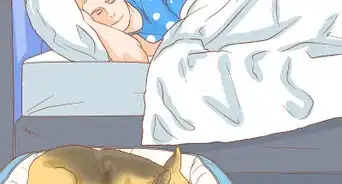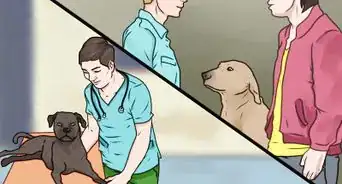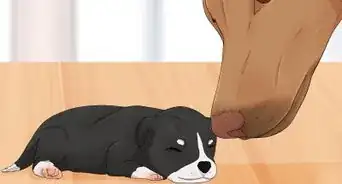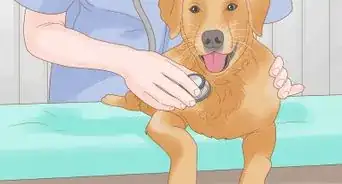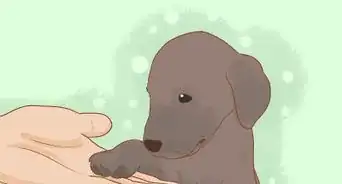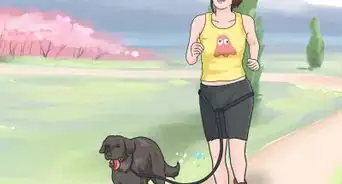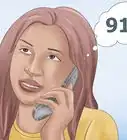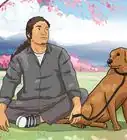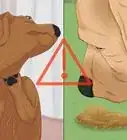This article was co-authored by Toni Woods. Toni Woods is a Professional Dog Trainer in Washington DC. With over 15 years of experience, Toni specializes in improving the relationship between dogs and their families and easing the suffering of dogs experiencing separation anxiety. Toni holds a BS in Biology from Wittenberg University and taught biology for nine years. She now dedicates her life to helping dogs with separation anxiety.
There are 10 references cited in this article, which can be found at the bottom of the page.
wikiHow marks an article as reader-approved once it receives enough positive feedback. In this case, several readers have written to tell us that this article was helpful to them, earning it our reader-approved status.
This article has been viewed 254,735 times.
Has your dog chewed up your favorite pair of penny loafers? Has he bit the mail carrier or the paper carrier too many times? Has he refused to play poker with you no matter how many times you’ve sat him up in a comfortable chair, dressed him up in a smoking jacket, and put a full house in his paws? Each one of these scenarios — ranging from the predictable to the unrealistic — could be considered “unwanted”. Ultimately, you’ll need to train your dog to exhibit “proper” behavior — however, you define it. In order to accomplish any of these goals, you’ll need to understand your dog’s decision-making process, assess why it makes the choices it does, and then train it to behave properly.
Steps
Assessing Causes of Behavioral Issues
-
1Determine the cause of your dog's behavior. Remember that your dog makes all of his choices out of his own self-interest. What is your dog getting for this behavior? Is it your attention, good or bad? Is it turning into a fun game for your dog? After establishing what is causing your dog to act in such a way, you’ll better understand how to change his behavior for the better.[1]
- Think broadly about your dog’s behavioral issues. Most likely, your dog is acting badly for a number of reasons. You should consider a number of factors including its diet and the amount of time it spends exercising or locked up in a kennel/cage/room.
-
2Look at your behavior. Do you leap to the dog's beck and call by yelling at it or cajoling it to stop? Maybe this is exactly what your pooch wants from you. Even angry attention is attention — your dog craves to be noticed and be part of the pack. If you only notice or give attention when your dog is acting up, you are responsible for "training" him to be bad.[2]Advertisement
-
3Look at your dog’s environment. Is there something almost “irresistible” in your dog’s space? This might take some detective work, or it may be incredibly obvious! If your dog chews on slippers, remove them. If your dog can’t help but bark at people walking outside your house, obstruct its view. Set your dog up for success. When your dog behaves properly, you can reward it. Without triggers, your dog will behave better.[3]
-
4Consider his diet. Is there a pattern to the start of his bad behavior that coincides with a change of diet? A lot like some kids with food or additive intolerances, some dogs can be intolerant of a particular ingredient or preservative in a food, and it shows it's as hyperactivity and bad behavior. If you suspect this to be the case, run a detox and either put him back on his original diet, or give him a bland (chicken and rice) diet for a couple of weeks and see if his behavior improves.
Fixing the Problem Behavior
-
1Don’t physically punish your dog. If you have punished your dog more than three times for the same behavior, your punishment is not appropriate. Remember - the definition of insanity is doing the same thing over and over and expecting different results! Punishing your dog will damage your relationship with your dog and possibly make the problem worse. A punishment does not have to be physical. Find alternatives that don’t injure or scare your dog. Do not hit or hurt your dog in any way. This breeds vicious, scared dogs, not lovable, huggable pooches.
- Never hit your dog. Just say "No!" firmly instead. Your dog will make the connection between his behavior and what you did to stop him.[4]
-
2Remove physical stimulants. If there are certain objects, toys, and plants in your house or garden that appear to "set off" your dog, remove them. Give your dog a toy that it likes that it will spend an hour playing with. Get a rawhide bone, a real bone, or a safe chew-toy. If there is some way to fill it with treats, your dog will spend even more time trying to get the treats out.[5]
-
3Consider clicker training to train your dog. Clicker training is a method of delivering immediate praise with the help of a clicker. You can click faster than you can give a treat or pet your dog's head. As such, clicker training reinforces good behavior fast enough for a dog's learning speed. It works by creating a positive association between the click sound and rewards. Eventually, your dog will consider the sound of the clicker itself reward enough for good behavior. You can apply the principle of clicker training to any dog command.[6]
- Click the clicker device, then immediately give the dog a treat. This creates a positive association with the click sound. Later, that sound will “mark” a behavior as correct so the dog knows that he did something right.[7]
- When the dog performs a desired behavior, make the click sound, then give him a treat. Once he's performing that behavior consistently, you can give the behavior a command name. Begin tying the command and the behavior together with the help of the clicker.
- For example, before you ever teach your dog the "sit" command, give the click sound, a treat, and praise when you find him sitting. When he begins sitting just to get the treats, start saying the word "sit" to get him into position. Pair it with the click sound to reward him. Eventually, he will learn that sitting in response to the "sit" command will earn him a click reward.[8]
-
4Reward the good behavior.[9] When your dog does a behavior you do want, such as laying down instead of barking, reward him or her. He will be much more likely to repeat the desired behavior and less likely to repeat the "bad" behavior. When incentives for bad behavior are withdrawn and incentives for good behavior are introduced consistently, the dog will soon learn the preferred response.[10]
-
5Tone down your behavior. Try to stop yelling, cajoling, or responding in any manner that gives the dog signals that you are excited, playful, dog-focused. Whilst you may feel very irritated, even angry, the dog may misinterpret this for playfulness or "joining in". Resist the temptation. Ignoring and silence is better than yelling — clean the mess up later after you send the dog elsewhere.
-
6Build trust. If your dog is running away from you and hiding, you have a lot of work to do to redevelop your damaged relationship with your dog. Your dog's trust in you has been damaged and it will take a lot of consistency and positive reinforcement training on your part to mend the broken relationship and turn it into something fabulous.
-
7Have patience. Training is a lifelong endeavor.[11] Your dog doesn't have the same contemplative powers that a human does. He can’t learn from one situation and extrapolate for others. To fundamentally change a dog’s behavior requires time and attention. If you have adopted your dog as an older dog with habits that seem to be set in stone, relax. The habits are not set. Remember, dogs are very context specific and that works to our favor. The dog now has a new pack and a new home and if you set the limits and expectations immediately when the dog arrives at his new home, he will learn. Sometimes when you are dealing with a hardwired behavior like a border collie that is herding the neighborhood kids instead of sheep, you cannot easily counter train that out. It is so much easier to manage the situation, rather than try to train him out of it. [12]
- How quickly a bad behavior stops depends on how well established it is. If the problem is an ingrained habit, then it can be difficult to break the association between action and reward. In fact, in the short or medium term the bad behavior can get worse because the dog works even harder to try and get the reward.[13]
Understanding Your Dog’s Psyche
-
1Understand that your dog learns by trial and error. You dog acts in a specific way because of an expected reward - whether it be food, play, or attention. When a dog behaves badly, think about what it gets out of it in terms of a reward and then make sure the reward does not happen. Unfortunately, to the canine mind attention is a huge addictive reward — which means shouting at your dog or telling him off is only rewarding the bad behavior. Any action can have three possible outcomes: a pleasant one, an uncertain one, or an unpleasant one.[14]
- What matters is the dog's response to those outcomes. Each outcome evokes a different response.
- The pleasant outcome, means the behavior is likely to be repeated
- An indifferent outcome, means the dog may or may not repeat the behavior
- An unpleasant outcome means the dog is less likely to repeat the behavior.
- Now when you realize that shouting or chastisement is a reward, it puts a whole different complexion on reacting to bad behavior — you are making the problem worse not better.[15]
-
2Understand that your dog makes direct connections. Dogs live in the moment. If your dog chews up your favorite shoe and you don’t punish him immediately, your dog won’t learn his lesson. If your mother comes home later, discovers the destroyed shoe, and slaps the dog, he will link the punishment to the owner who came home and for no reason slapped him. Thus, he becomes wary of the owner. The dog learns nothing about the inherent evils of shoe chewing.[16]
- Punishment isn’t clear for dogs oftentimes. If you catch the dog in the act of chewing a shoe, and tell him off immediately, once again he might simply link the punishment to the owner rather than to the inanimate object he’s destroyed.
-
3Think about your dog's routine. Remember that your dog is a creature of habit. Determine if your dog is boredom or anxious. Boredom and a surplus of energy can turn a normally well-behaved dog into a delinquent. Make sure he has plenty of regular exercise and plenty of opportunity to express physical energy chasing and running. This leaves him happily content when he gets back home and less likely to get up to mischief.[17]
- If your dog is destructive when you're out, consider that he might be anxious or bored in your absence. Try giving him a toy that will consume his attention for 20 to 30 minutes — such as a Kong stuffed with dog food. In hot weather, stuff the Kong and pop it in the freezer overnight, so that he gets a cooling dog-food ice pop to keep his mind occupied whilst you’re out. The chances are if he gets over the initial half an hour without noticing you're gone then he's more likely to settle down for a nap afterwards.[18]
Expert Q&A
Did you know you can get expert answers for this article?
Unlock expert answers by supporting wikiHow
-
QuestionHow do I stop my dog from chewing?
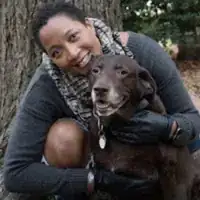 Toni WoodsToni Woods is a Professional Dog Trainer in Washington DC. With over 15 years of experience, Toni specializes in improving the relationship between dogs and their families and easing the suffering of dogs experiencing separation anxiety. Toni holds a BS in Biology from Wittenberg University and taught biology for nine years. She now dedicates her life to helping dogs with separation anxiety.
Toni WoodsToni Woods is a Professional Dog Trainer in Washington DC. With over 15 years of experience, Toni specializes in improving the relationship between dogs and their families and easing the suffering of dogs experiencing separation anxiety. Toni holds a BS in Biology from Wittenberg University and taught biology for nine years. She now dedicates her life to helping dogs with separation anxiety.
Professional Dog Trainer
-
QuestionHow do I stop my dog from sniffing other dogs' butts?
 Pippa Elliott, MRCVSDr. Elliott, BVMS, MRCVS is a veterinarian with over 30 years of experience in veterinary surgery and companion animal practice. She graduated from the University of Glasgow in 1987 with a degree in veterinary medicine and surgery. She has worked at the same animal clinic in her hometown for over 20 years.
Pippa Elliott, MRCVSDr. Elliott, BVMS, MRCVS is a veterinarian with over 30 years of experience in veterinary surgery and companion animal practice. She graduated from the University of Glasgow in 1987 with a degree in veterinary medicine and surgery. She has worked at the same animal clinic in her hometown for over 20 years.
Veterinarian
-
QuestionWhat causes aggressive behavior in a puppy?
 Pippa Elliott, MRCVSDr. Elliott, BVMS, MRCVS is a veterinarian with over 30 years of experience in veterinary surgery and companion animal practice. She graduated from the University of Glasgow in 1987 with a degree in veterinary medicine and surgery. She has worked at the same animal clinic in her hometown for over 20 years.
Pippa Elliott, MRCVSDr. Elliott, BVMS, MRCVS is a veterinarian with over 30 years of experience in veterinary surgery and companion animal practice. She graduated from the University of Glasgow in 1987 with a degree in veterinary medicine and surgery. She has worked at the same animal clinic in her hometown for over 20 years.
Veterinarian It is rare for a young puppy to be truly aggressive. However, lack of socialization can make a puppy wary of things around him, and he may growl or snap out of fear. He may also learn that if he nips, people back off so he uses this to keep some personal space. It is important to correct this trend at a young age. Seek the help of a reputable dog trainer or behaviorist, and in the meantime work on rewarding good behavior and distracting him with a toy from situations where he may threaten to bite.
It is rare for a young puppy to be truly aggressive. However, lack of socialization can make a puppy wary of things around him, and he may growl or snap out of fear. He may also learn that if he nips, people back off so he uses this to keep some personal space. It is important to correct this trend at a young age. Seek the help of a reputable dog trainer or behaviorist, and in the meantime work on rewarding good behavior and distracting him with a toy from situations where he may threaten to bite.
References
- ↑ https://www.aspca.org/pet-care/virtual-pet-behaviorist/dog-behavior/training-your-dog
- ↑ https://www.aspca.org/pet-care/virtual-pet-behaviorist/dog-behavior/training-your-dog
- ↑ http://www.animalhumanesociety.org/training/destructive-behavior-dogs
- ↑ http://www.perfectpaws.com/whytr.html#.VZsweXiH2cM
- ↑ http://www.veterinarypartner.com/Content.plx?A=1574
- ↑ http://www.aspca.org/pet-care/virtual-pet-behaviorist/clicker-training-your-pet
- ↑ http://www.aspca.org/pet-care/virtual-pet-behaviorist/clicker-training-your-pet
- ↑ http://www.aspca.org/pet-care/virtual-pet-behaviorist/clicker-training-your-pet
- ↑ Toni Woods. Professional Dog Trainer. Expert Interview. 11 November 2020.
- ↑ http://www.humanesociety.org/animals/dogs/tips/dog_training_positive_reinforcement.html
- ↑ Toni Woods. Professional Dog Trainer. Expert Interview. 11 November 2020.
- ↑ Don't Shoot the Dog. Karen Pryor. Publisher: Ringpress Books
- ↑ The Happy Puppy Handbook. Pippa Mattinson. Publisher: Ebury Digital
- ↑ https://www.aspca.org/pet-care/virtual-pet-behaviorist/dog-behavior/training-your-dog
- ↑ Don't Shoot the Dog. Karen Pryor. Publisher: Ringpress Books
- ↑ https://www.aspca.org/pet-care/virtual-pet-behaviorist/dog-behavior/training-your-dog
- ↑ Toni Woods. Professional Dog Trainer. Expert Interview. 11 November 2020.
- ↑ http://www.cesarsway.com/channel/dog-behavior/dog-anxiety
About This Article
To stop a dog's unwanted behavior, speak and react to your dog calmly rather than yelling at it, since dogs don't respond well to verbal or physical punishment. You can say "No!" firmly and in a tone of voice reserved only for bad behavior. Be sure to remove any objects, toys, or plants that negatively stimulate your dog and reward good behavior with verbal praise and treats to positively reinforce that behavior! For tips on understanding your dog's behavioral issues, read on!
